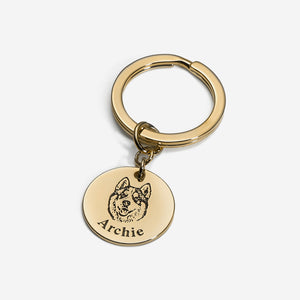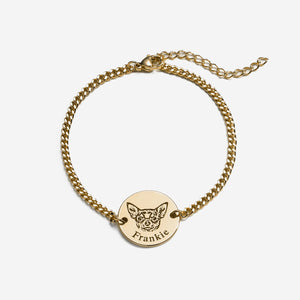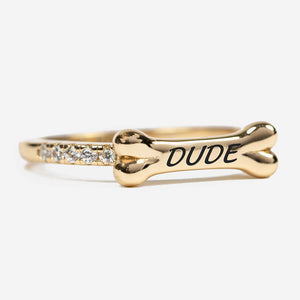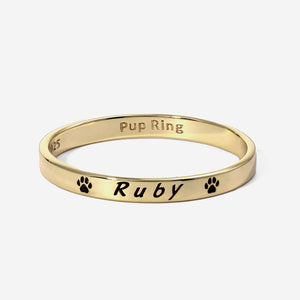Chances are you may be eating a little less healthy lately. Heck, I ate a whole bag of pizza rolls in a single day last week, so I’m right there with you. What about your dog though? Hopefully your pup’s health is as good as ever with you by their side all day!
My dog Cookie is OBSESSED with fruits and vegetables. He will try almost anything I give to him. If I chop up an apple or a carrot, he is excitedly waiting by my side hoping for a piece. Oh, by the way, try not to feed these treats from the table- you don’t want to teach them to start begging! Anyway, if your dog isn’t always excited at the prospect of munching on the first piece of produce you offer, there are tons of different fruits and veggies you can try until you find what your dog likes.
The best part of this is that once you find something your dog loves to munch on, it’s not only good for them, but it’s also easy to keep a bowl of healthy snacks for both of you! When you change your environment to make the better choices easier to make, you are setting yourself up for success. So if you’re looking to eat better yourself, then having a healthy snack within reach instead of a jar of cookies is a great way to make mindless munching a little better. After all, you can’t give that whole orange to your dog at once, so you might as well enjoy some. If you have kids, this can also be a fun way to convince them it’s fun to eat something that doesn’t come from a microwave.
However, not everything that grows in the ground (or comes out of your kitchen) is safe for your dog to eat. To help you out, here’s a guide to what your dog can enjoy, what it can’t, and some easy ways to step up your treat game!
Safe Treats
Veggies- Broccoli, green beans, cucumbers, peas, celery, carrots
My dog Cookie is obsessed with veggies! The celery and carrots are especially good for doggy breath, and they are fun to chew on! Just be sure to cut up any large veggies, or if your dog is in the mood to munch on a whole one, supervise them closely to make sure they’re not swallowing any large chunks. Also, I honestly have no idea why he finds broccoli appealing, but to each his own. Just make sure that if you’re sharing your snacks, you don’t let your dog indulge in the condiments or dips you like to use, such as ranch dressing.
Fruits- Apples, oranges, bananas, strawberries, blueberries, raspberries
Fruits are a nice subtly sweet treat for your dog! Of course some will require peeling, and it’s a good idea to separate larger fruits into chunks for your pup to make it easier for them to safely eat. It’s a good idea to share these! You won’t necessarily want to give your dog the whole fruit, so it’s a great chance to snack on some yourself, or share some with others. Berries, on the other hand, are a little quicker- just rinse and dispense!
If you give your dog an apple, be certain to cut out the seeds and the small area surrounding them- they contain small amounts of cyanide that can be harmful to your dog. If your dog isn’t interested at first, or you’re feeling especially generous, you can add a little peanut butter to it!
Not Safe, Don’t Share!
Produce: Tomatoes, avocados, cherries, fruit seeds, grapes, raisins, onions, garlic
Not everything that grows on a tree or a vine or in the dirt is good for your dog. Just like you wouldn’t eat poison ivy, there are some plants that are poisonous to your dog. Tomatoes, grapes, raisins, onions, and garlic all contain naturally occurring compounds that are toxic to your dog.
 Cherries, as well as any fruit seed such as apple seeds, peach pits, and others, contain cyanide. Usually removing seeds, pits, and cores is enough to render your fruit puppy-approved, just be generous when removing the flesh around the seeds too. Cherries are just not big enough to remove the seed and still be safe.
Cherries, as well as any fruit seed such as apple seeds, peach pits, and others, contain cyanide. Usually removing seeds, pits, and cores is enough to render your fruit puppy-approved, just be generous when removing the flesh around the seeds too. Cherries are just not big enough to remove the seed and still be safe. Ingredients: Xylitol, garlic or onion flavoring
Some peanut butter is now made with Xylitol or other artificial sweeteners which can be extremely toxic to your dog. Be sure to check the ingredients in this common doggy treat. I tend to opt for peanut butter with simple ingredients and no sweeteners added for myself anyway (I gotta eat better too, right?)
When you open up a bag of dog treats that smell super strong and savory, take a peek at the ingredients on those too. Even though they’re made for dogs, not all treats are created equal. If you see onion or garlic on that label, it’s not for your dog’s nutritional benefit, it’s just to make them smell more appetizing to you and tempt you to choose them over their competition. Of course you won’t be snacking on dog treats anytime soon anyway, so look for treats that don’t contain these ingredients, no matter how yummy they smell.
Raw meat or bones- While a raw diet for dogs is becoming more popular these days as we all become more health conscious, the safety of this diet is up for debate. Many veterinarians, as well as the FDA, disagree with the safety of this diet.
There are both benefits and risks when it comes to a raw food diet- Dogs may appear to have shinier coats, cleaner teeth, or healthier skin. However, it’s possible that this anecdotal evidence comes from owners who weaned their dog off of a low-quality kibble. There are big risks with a raw diet including illness due to bacteria in raw meat, raw bones causing broken teeth or internal punctures, and a lack of important nutrients they have grown to need over time.
 While a common idea is that feeding a dog what its ancestors ate is ideal, a dog’s nutritional needs have changed over thousands of years as they were domesticated. As they grew closer with men, new foods were added to their diet and they adapted to the nutrients now available for their consumption. For example, puppies today now require calcium in order to grow and develop properly, which they can’t get out of a raw diet.
While a common idea is that feeding a dog what its ancestors ate is ideal, a dog’s nutritional needs have changed over thousands of years as they were domesticated. As they grew closer with men, new foods were added to their diet and they adapted to the nutrients now available for their consumption. For example, puppies today now require calcium in order to grow and develop properly, which they can’t get out of a raw diet.
 Even if a dog does not get sick from the bacteria in raw meat, it can pass through their digestive system and still make other dogs or humans sick. Now that much of our meat comes from animals treated with antibiotics, any salmonella that comes with it tends to be antibiotic-resistant and hard to treat. If your dog eats raw meat, you need to be extremely careful about cross-contamination, be sure not to leave it out at room temperature, carefully pick up after your dog, and don’t allow it to lick anyone’s face, as any bacteria from the meat gets in its mouth and is no longer safe for you to touch.
Even if a dog does not get sick from the bacteria in raw meat, it can pass through their digestive system and still make other dogs or humans sick. Now that much of our meat comes from animals treated with antibiotics, any salmonella that comes with it tends to be antibiotic-resistant and hard to treat. If your dog eats raw meat, you need to be extremely careful about cross-contamination, be sure not to leave it out at room temperature, carefully pick up after your dog, and don’t allow it to lick anyone’s face, as any bacteria from the meat gets in its mouth and is no longer safe for you to touch.
I know you have your dog’s best interests in mind. If you worry that the kibble you give your dog isn’t good enough, know that all dog food is not created equal. There are many high-quality dog foods available, made specially to promote your dog’s optimal health, sometimes even formulated differently for dogs with different needs. And, of course, you can always add some of these healthy treats on this list to their diet.
In moderation/with consideration
Peanut butter- This is a big one you should be very picky about! We all know dogs love peanut butter, but you need to look closely at the ingredients listed on the jar you have. If you plan to give peanut butter to your dog, it MUST NOT contain Xylitol. Xylitol is an artificial sweetener, and it is very toxic to dogs. Even within the same brand of peanut butter, sometimes ingredients change between styles or even the manufacturer’s general recipe.
Even when you choose a peanut butter that is safe for your dog, don’t feed them spoonful after spoonful - keep it as a very special treat! It is best utilized to amp up your healthy-treat game or use with training tools and toys! For example, if you’re introducing chew toys to your dog, rubbing a bit of peanut butter on it is a great way to get them started. Chew toys help your dog clean their teeth, prevents them from chewing non-appropriate objects, and is a great way to stimulate their brain.
If you have a hound that is especially in need of some brain-teasers, you can put part of their normal meal inside of a kong chew toy, seal the bottom off with peanut butter, and put it in the freezer for a bit. This is a great way to slow down a dog that inhales their meals a little too quickly, and keep them occupied and well-behaved for a while.
 Rawhide- Although rawhide can be a popular choice in the pet store, recently there have been questions about how safe it really is for dogs. The first consideration should be whether the product itself comes from a good source without any harmful treatments or chemicals applied. Your best bet when looking for a higher quality rawhide is to stick to locally sourced brands (rawhide produced here in North America, for example). Second, depending how your dog chooses to snack on rawhide, it could easily become a choking hazard. When feeding treats like this, you should always supervise your dog to make sure it’s not swallowing large chunks that it could choke on. Even if your dog has not had issues with rawhide before, it’s still a good idea to supervise them.
Rawhide- Although rawhide can be a popular choice in the pet store, recently there have been questions about how safe it really is for dogs. The first consideration should be whether the product itself comes from a good source without any harmful treatments or chemicals applied. Your best bet when looking for a higher quality rawhide is to stick to locally sourced brands (rawhide produced here in North America, for example). Second, depending how your dog chooses to snack on rawhide, it could easily become a choking hazard. When feeding treats like this, you should always supervise your dog to make sure it’s not swallowing large chunks that it could choke on. Even if your dog has not had issues with rawhide before, it’s still a good idea to supervise them.
I personally don’t give Cookie rawhide because I’m picky about what I feed him and don’t want to take chances with certain pre made dog treats when I know he’s already so excited about eating a chunk of broccoli.
Dairy- While it may seem fun and harmless to feed your dog a slice of cheese, it should only be given in very small amounts if at all. Itisn’t necessarily toxic or anything, it just has a tendency to upset their stomach and cause some.. Stinky problems, to put it nicely. Dogs can’t process large amounts of lactose so it’s probably best to opt for other options. However, yogurt is okay, as long as you opt for plain yogurt without sweeteners or flavors.
Eggs- Only if they’re fully cooked! Eggs are packed with some awesome nutritional value, but raw eggs can make your dog sick. Next time you cook eggs for breakfast, feel free to make one properly and unseasoned snack for your dog.
Cooked Poultry- If you plan to share some chicken or turkey, your biggest concern should be the bones. Bones might seem like a natural, and therefore safe thing for dogs to eat, but cooked bones can easily splinter and wreak havoc on your dog’s throat, stomach, and digestive system, potentially causing punctures and requiring surgery. If you plan to share poultry with your pup, make sure it is fully cooked and isn’t seasoned.
The best way to stay healthy together
 In the end we all want to make the best choices when it comes to our dogs. Take some time to learn what healthy foods your dog likes! Trying new foods can make things interesting and even challenge your dog’s mind a bit. Once you figure out their favorite foods, you can keep some on hand and share snack time together. You can use this to your advantage, take the opportunity to make some healthy food swaps yourself, and enjoy living a better life together with your pup.
In the end we all want to make the best choices when it comes to our dogs. Take some time to learn what healthy foods your dog likes! Trying new foods can make things interesting and even challenge your dog’s mind a bit. Once you figure out their favorite foods, you can keep some on hand and share snack time together. You can use this to your advantage, take the opportunity to make some healthy food swaps yourself, and enjoy living a better life together with your pup.
What is your dog’s favorite treat? Feel free to let us know! Thanks so much for reading, and for caring so much about your dog’s health. I hope you’re staying healthy and happy, and I look forward to writing for you again next week!







